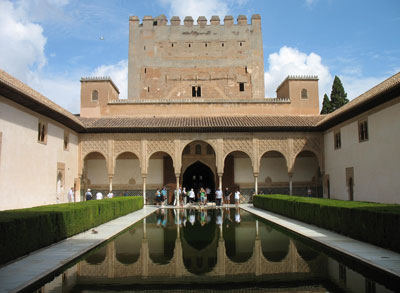Spain’s Alhambra – the heart of Muslim Granada
View(s):By Sanjiva Wijesinha

El patio de Los Arroyanes (The Courtyard of the Myrtles)
The world’s most visited UNESCO World heritage site – the Alhambra (from the Arabic Al-Qalat al-Hamrah, the Red Fortress) with its adjacent Generalife (from Jannat Al-Arif, the Garden of the Architect) – attracts over 7000 visitors daily to Spain’s southern city of Granada.
The Alhambra complex includes several tourist sights well worth visiting – the Nasrid palaces which were homes to the sultans, the ancientAlcazaba citadel with its watchtowers dating back to the ninth century, the Generalife which is a leisure residence with beautiful gardens and the Fine Arts Museum housed in the former palace of King Carlos the Fifth.
The entrance fees from all the visitors to the Alhambra add over ten million Euros each year to the nation’s coffers. Situated about an hour’s flight from Madrid and ninety minutes from Barcelona, the city is easily accessible from the country’s international airports.
Granada was the last Muslim kingdom in Spain to be conquered by the Catholic monarchs Ferdinand and Isabella. Under its Nasrid rulers, it flourished from 1238 to 1492 and enjoyed such economic prosperity that it reached an artistic zenith. Although many Muslim buildings were destroyed after the Christian conquest, those that remain today are certainly beautiful examples of Moorish domestic architecture – and a reminder of the cultural influence that seven centuries of Islamic rule had on this country.
The Alhambra was the residence of the ruler as well as his court, and consists of a fairy tale collection of palaces standing atop a wooded hill overlooking the modern city. Built around courtyards filled with flowers, fruit trees and fountains, where tranquil pools and the gentle sound of flowing water created a “paradise on earth”, the Alhambra epitomises the aesthetic refinement of Spain’s sophisticated Moorish civilization – which was popularised by American writer Washington Irving in his romantic Tales of the Alhambra.
Covering the ceilings and walls of the palace are intricate sculptures and imaginative decorations of exquisite hand crafted stuccowork and richly coloured ceramic tiles. Without using any images of humans, animals or even flowers, the painters and sculptors of the walls of the Alhambra made use of calligraphy and mosaics to form geometric patterns and create artwork of unique beauty and elegance. Among the highlights to be seen here are
n the Hall of the Ambassadors with its magnificent hand carved cedar-wood ceiling
n the Sultan’s Audience Hall which has a full chapter of the Koran engraved in Kufi script around its wall
n the Myrtle Courtyard (El Patio de los Arrayones) with its rectangular pool surrounded by myrtle trees. In the water can be seen the reflected image of the Comares Tower
n the Generalife gardens with their charming patios and Water Staircase.
Within the grounds of the Alhambra stands the impressive Palace built after the conquest by King Carlos V (The Holy Roman Emperor Charles V) inside which are the Museum of the Alhambra and the Museum of Fine Arts.
Another building set amidst the fountains and gardens of the Alhambra complex that must be seen is the Parador Nacional of Granada, a 15th century convent that has been tastefully converted into a modern hotel. Enjoy a meal here – or even spend a couple of nights, as did Prince Rainier and Princess Grace of Monaco on their honeymoon!
One of the most beautiful views of the Alhambra, particularly at night, is from the Albaicin – the old quarter of Granada on the opposite bank of the Darro river where the Muslim conquerors from North Africa built their first fortress – and to which they withdrew after Granada was conquered in 1492 by the Catholic Monarchs.
In Nasrid times the splendour of the city was such that an Arab poem described Granada with the words: “the East envies the West in me…”
Today’s visitors to the Alhambra and Generalife would surely agree that the West can with good reason envy the East in these awe-inspiring monuments of Granada.


